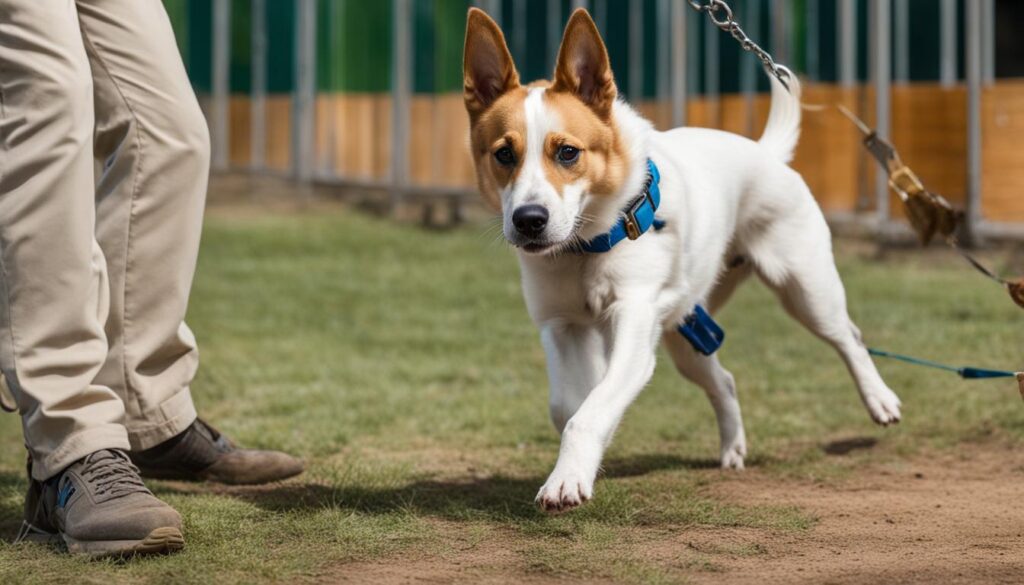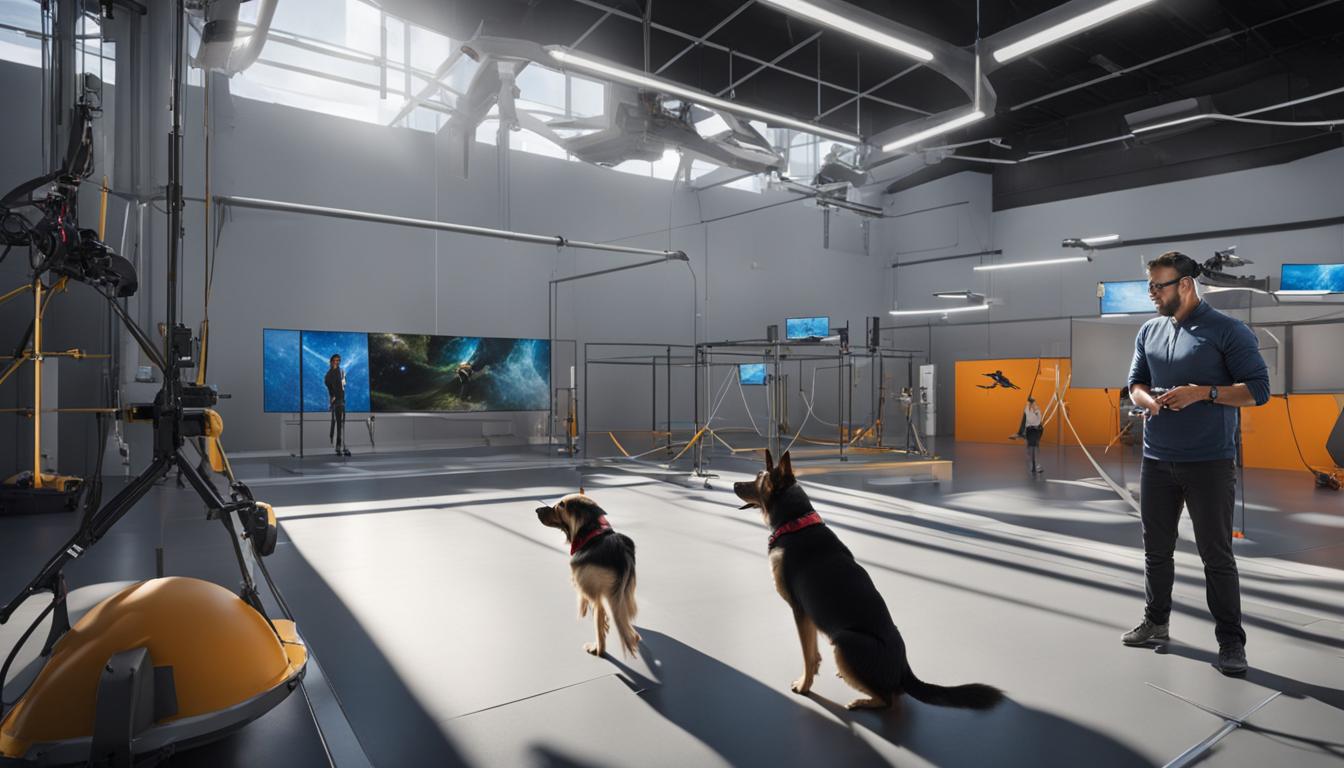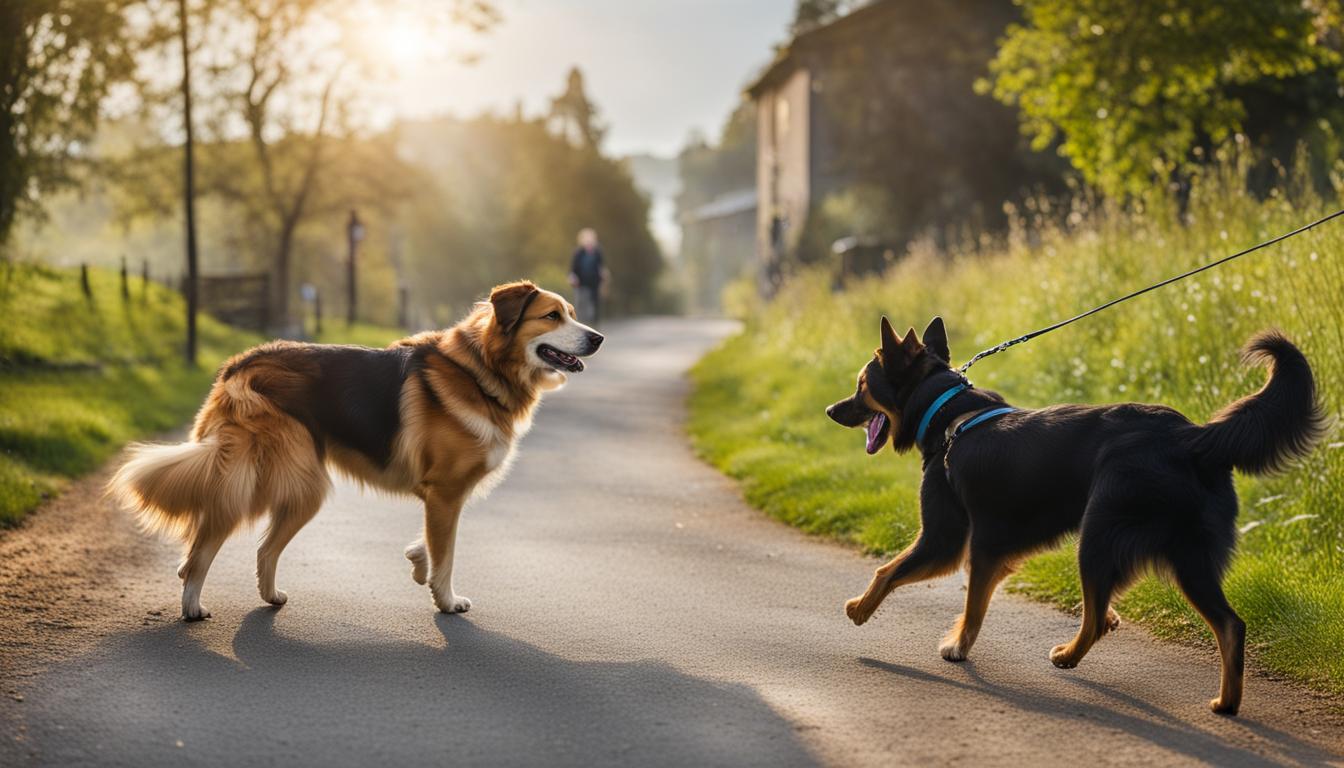Training dogs with a history of abuse can be a challenging but rewarding process. It takes time, patience, and understanding to build trust and confidence in these dogs. Depending on their individual experiences, the recovery process may vary. It’s important to approach training with a calm temperament and provide the dog with a quiet, safe space. High-quality food and treats can help address any malnourishment or deficiencies caused by a poor diet. Having realistic expectations and tons of patience is essential, as each dog’s journey to recovery will be unique.
Key Takeaways:
- Training abused dogs requires time, patience, and understanding.
- Creating a calm and safe environment is crucial for trust building.
- High-quality nutrition can help address any dietary deficiencies.
- Realistic expectations and patience are essential for the recovery process.
- Each dog’s journey to recovery will be unique.
Reasons Your Dog Can Have Trust Issues
Building trust with a traumatized dog is a crucial part of their rehabilitation process. Understanding the reasons behind their trust issues can help you tailor your approach and create a safe environment for them. Here are some common reasons why dogs may have trust issues:
- Lack of socialization: Dogs that have not been properly socialized during their early development stages may struggle to trust humans and other animals. Limited exposure to different environments, people, and other dogs can lead to fear and anxiety.
- Traumatic experiences: Dogs who have experienced abuse, neglect, or any other traumatic events can develop deep-seated fear and mistrust towards humans. The memories of their past can make it challenging for them to trust and form new bonds.
- Genetics: Some dogs may have a genetic predisposition to anxiety and fear, making them more prone to developing trust issues. It’s important to understand their genetic background to better understand their behavior and tailor your training approach accordingly.
By identifying the underlying reasons for your dog’s trust issues, you can approach their training and rehabilitation with compassion, patience, and tailored strategies.
Overcoming Fear in Abused Dogs
“Fear is the path to the dark side. Fear leads to anger. Anger leads to hate. Hate leads to suffering.” – Yoda
When it comes to helping an abused dog overcome fear, it’s essential to create a safe and nurturing environment. Here are some tips to consider:
- Patience and consistency: Building trust takes time, so it’s important to be patient and consistent in your interactions with the dog. Avoid rushing or forcing them into situations that may trigger their fear.
- Positive reinforcement: Focusing on positive reinforcement techniques can help build trust and confidence in your dog. Reward them with treats, praise, and affection when they display calm and confident behavior.
- Professional guidance: Seek the help of a professional dog trainer or behaviorist who specializes in working with traumatized dogs. They can provide you with valuable insights and techniques tailored to your dog’s specific needs.
Remember, each dog is unique, and their recovery journey will be different. With time, patience, and love, you can help your dog overcome their trust issues and build a stronger bond.
| Reasons for Trust Issues | Suggested Approach |
|---|---|
| Lack of socialization | Gradual exposure to new environments, people, and dogs. Positive reinforcement for calm behavior. |
| Traumatic experiences | Creating a safe and nurturing environment. Slowly introducing positive experiences and rebuilding trust. |
| Genetics | Understanding genetic predispositions and tailoring training methods to suit individual needs. |
Understanding the reasons behind your dog’s trust issues and implementing the suggested approaches can help them overcome their fears and develop a stronger bond with you.

Training Abused Dogs Safely
Training an abused dog requires special care and consideration to ensure their safety and well-being. Here are some guidelines to keep in mind:
- Use positive reinforcement: Reward desired behavior with treats, praise, and affection. Avoid punishment-based training methods, as they can further contribute to anxiety and fear.
- Create a calm environment: Provide a quiet and safe space for your dog to relax and feel secure. Minimize loud noises and sudden movements that may trigger their anxiety.
- Set realistic expectations: Understand that it may take longer for an abused dog to learn new behaviors compared to dogs without a traumatic past. Be patient and celebrate small victories along the way.
Remember, your dog’s trust and confidence are fragile, but with gentle guidance, they can overcome their past and thrive in a loving and supportive environment.
How to Build Trust with Your Dog
Building trust with an abused dog requires patience, consistency, and a deep understanding of their individual needs. It’s crucial to learn to read their body language and recognize signs of fear and anxiety. Respecting their space and allowing them to set the pace are essential. Avoiding punishment and using positive reinforcement, such as treats and praise, can help create a safe and encouraging environment for the dog. Consistency in training methods and routines is important to establish trust. Providing a safe space and engaging in trust-building activities, such as play and rewards-based training, can further strengthen the bond between the dog and the owner.
When working with an abused dog, the healing process takes time. It’s important to be patient and understanding throughout their journey of recovery. The dog may have deep-rooted fears and anxieties that require gentle guidance and support. Establishing a routine and consistent training schedule can provide a sense of security for the dog and help build their confidence.
Remember, healing from past abuse is a process, and each dog will respond differently. Be kind, patient, and understanding as you work to build trust and confidence with your dog. – Anonymous
One effective technique for building trust is to engage in positive socialization experiences with other dogs and people. This can help the abused dog learn that not all interactions are negative or harmful. However, it’s important to introduce new experiences gradually and in a controlled manner. Overwhelming the dog with too much stimulation too soon can hinder progress and cause setbacks.
By implementing these techniques and providing a loving and supportive environment, you can help your abused dog heal from past trauma and build confidence. Remember to always consult with a professional dog trainer or behaviorist to ensure you are using appropriate methods for your dog’s specific needs.
Table: Trust-Building Activities for Abused Dogs
| Activity | Description |
|---|---|
| Slow, Gentle Touch | Gently stroke the dog’s back or neck, observing their response and comfort level. Gradually increase the duration and intensity of touch as their trust grows. |
| Rewards-Based Training | Use treats and positive reinforcement to reward desired behaviors. This creates a positive association with training and helps the dog feel safe and supported. |
| Interactive Play | Engage in interactive play sessions with the dog, using toys or games that they enjoy. This creates a fun and positive experience, while also building trust and confidence. |
| Quiet, Safe Space | Provide a designated area where the dog can retreat to when they feel overwhelmed or anxious. This space should be comfortable, quiet, and free from any potential triggers. |
| Positive Socialization | Gradually introduce the dog to new dogs and people in a controlled environment. This can help them develop positive associations and build confidence in social situations. |
Take it slow
When it comes to training a rescue dog with a history of abuse or neglect, it’s essential to take things at a slow pace. These dogs have been through traumatic experiences and need time to adjust to their new environment and build trust with their new owner. Rushing or pushing them too quickly may cause them to become fearful or anxious, hindering their progress.
Creating a safe and controlled environment is key to helping these dogs feel more comfortable and confident. Set up a designated area in your home where the dog can retreat to whenever they feel overwhelmed or need some downtime. This space should be quiet, cozy, and free from any potential triggers that may remind them of their past trauma.
Additionally, it’s important to introduce new experiences gradually. Start with simple, positive interactions and then slowly expose the dog to new people, animals, and environments. Remember to always monitor their behavior and comfort level and make adjustments accordingly. Taking the time to socialize your previously abused dog in a safe and controlled manner will help them build confidence and trust in the world around them.

Benefits of Taking it Slow:
- Reduces stress and anxiety
- Allows the dog to build confidence at their own pace
- Helps establish a stronger bond between the dog and owner
- Prevents potential setbacks in the training process
“Patience and a gradual approach are essential when working with abused dogs. By taking it slow and providing a safe environment, we can help these dogs heal and learn to trust again.” – Dog Trainer
Use positive reinforcement
Positive reinforcement is a gentle and effective training method for abused dogs. By rewarding good behavior with treats, praise, and affection, you can help the dog associate positive experiences with you, their owner. This approach creates a positive and encouraging training environment that helps abused dogs build trust and confidence.
Instead of punishing undesired behaviors, positive reinforcement focuses on ignoring or redirecting those behaviors. This shift in approach helps prevent the dog from feeling fearful or anxious, as they are not being punished. Instead, they are being taught what behavior is desired through rewards and positive experiences.
The key to using positive reinforcement effectively is consistency and timing. Make sure to provide the reward immediately after the desired behavior occurs, so the dog can make the connection between their action and the reward. Consistency in using positive reinforcement throughout the training process will reinforce good behavior and strengthen the bond between you and your dog.

Benefits of Positive Reinforcement
- Builds trust and confidence: Positive reinforcement helps abused dogs feel safe and secure, which is crucial in building trust and confidence.
- Creates a positive training environment: Dogs learn more effectively when they associate training with positive experiences, making the process more enjoyable for both you and your dog.
- Strengthens the bond between you and your dog: By using positive reinforcement, you are nurturing a relationship based on trust, love, and mutual respect.
- Improves overall well-being: Positive reinforcement promotes a dog’s mental and emotional well-being, leading to a happier and healthier pet.
Remember, each abused dog is unique, and their journey to recovery will vary. Patience, understanding, and positive reinforcement are key in helping them heal and thrive in their new loving home.
Conclusion
Training abused dogs can be a challenging but fulfilling journey. By using rehabilitation techniques for rescue dogs, building confidence in abused dogs, and training them safely, you can help these dogs heal and thrive in their new homes.
Remember, patience and compassion are key. Creating a calm and safe environment for your dog is crucial in building trust. Utilize positive reinforcement to reward good behavior, rather than using punishment-based methods.
If you find yourself struggling or needing extra guidance, don’t hesitate to seek professional help. Rehabilitation techniques for rescue dogs require a deep understanding of their unique experiences, and professionals can provide valuable insights and support.
With time and dedication, your abused dog can overcome their past trauma and develop a stronger bond with you. Together, you can create a loving and secure environment where your dog can thrive and experience the happiness they deserve.
FAQ
What are some effective training techniques for dogs with a history of abuse?
Effective training techniques for dogs with a history of abuse include building trust and confidence through patience, consistency, and positive reinforcement. It’s important to provide a calm and safe environment and to understand their individual needs and body language.
Why do dogs develop trust issues?
Dogs can develop trust issues due to lack of socialization, traumatic experiences, or genetics. Dogs who have been abused or neglected may particularly struggle with trust, which can impact their mental health and overall well-being.
How can I build trust with my abused dog?
Building trust with an abused dog requires patience, consistency, and understanding. It’s important to respect their space, use positive reinforcement, and create a safe and encouraging environment. Learning to read their body language and allowing them to set the pace are also essential.
How should I take things at a slow pace when training an abused dog?
When training a rescue dog with a history of abuse or neglect, it’s important to provide a safe and controlled environment where the dog can gradually feel more comfortable and confident. Rushing or pushing them too quickly may cause fear or anxiety.
What is positive reinforcement and why is it effective for abused dogs?
Positive reinforcement is a gentle and effective training method for abused dogs. It involves rewarding the dog with treats, praise, and affection for good behavior. This helps the dog associate positive experiences with their owner and creates a positive and encouraging training environment.
How can I help my abused dog overcome their past trauma and build confidence?
Helping your abused dog overcome their past trauma and build confidence requires compassion, patience, and understanding. By providing a calm and safe environment, using positive reinforcement, and seeking professional help if needed, you can help your rescue dog heal and thrive in their new loving home.





